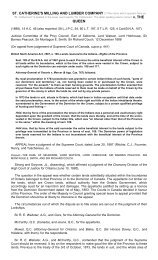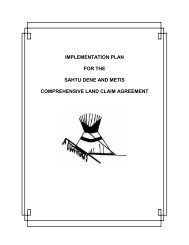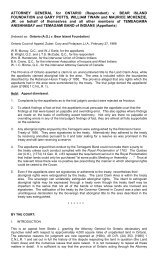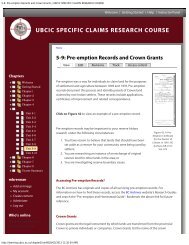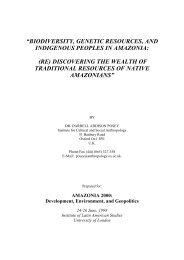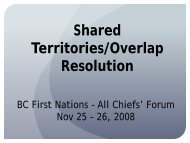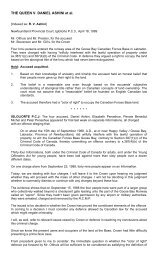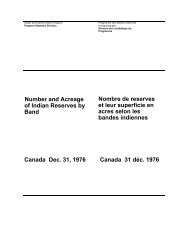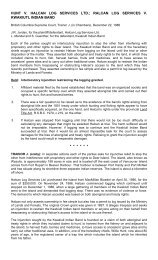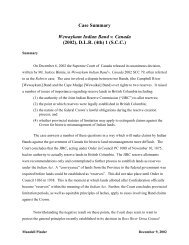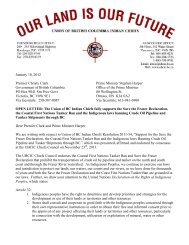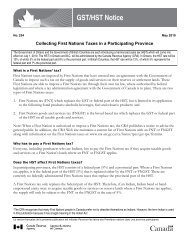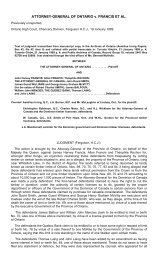Constitutional âPropertyâ and Reserve Creation: Seybold Revisited
Constitutional âPropertyâ and Reserve Creation: Seybold Revisited
Constitutional âPropertyâ and Reserve Creation: Seybold Revisited
You also want an ePaper? Increase the reach of your titles
YUMPU automatically turns print PDFs into web optimized ePapers that Google loves.
4 MANITOBA LAW JOURNAL VOL 32 NO 1It is impossible to read s. 109 purposively, that is in light of its constitutional<strong>and</strong> historical context, without recognizing that the Crown is indivisible for thepurpose of l<strong>and</strong> ownership. Lord Watson confines the provincial interest to therevenues from Crown l<strong>and</strong>s <strong>and</strong> the disposal of Crown l<strong>and</strong>s. This is a limitedinterest granted to the legislature in Canada after the rebellions of the 1830s <strong>and</strong>the controversies over l<strong>and</strong> that surrounded them. It entitled the then coloniallegislatures of British North America to administer <strong>and</strong> derive revenues fromCrown l<strong>and</strong>s without authorization from the Crown that had been requiredsince the fall of Quebec. 11 It was this same power which was incorporated intothe British North America Act in 1867. Section 109 of that Act reads:All L<strong>and</strong>s, Mines, Minerals, <strong>and</strong> Royalties belonging to the several Provinces of Canada,Nova Scotia, <strong>and</strong> New Brunswick at the Union, <strong>and</strong> all Sums then due or payable forsuch L<strong>and</strong>s, Mines, Minerals, or Royalties, shall belong to the several Provinces of Ontario,Quebec, Nova Scotia, <strong>and</strong> New Brunswick in which the same are situate or arise,subject to any Trusts existing in respect thereof, <strong>and</strong> to any Interest other than that ofthe Province in the same. 12The first part of s. 109 deals with provincial capacity to dispose of l<strong>and</strong> (the l<strong>and</strong>shall “belong” to the provinces), while the second part deals with the ability toderive revenue (all sums due or payable) <strong>and</strong> gain Royalties. Read purposively s.109 grants provinces the power to derive revenues <strong>and</strong> make grants, while the“royalty” power provides for tenures like escheat. 13 This interest of the provincediffers fundamentally from a “radical” or “underlying” or legal title in the l<strong>and</strong>.The term “belonging to” the provinces must be read in light of the purpose ofthe Constitution Act, 1867. For example, the words “between the Dominion <strong>and</strong>the provinces, all powers executive <strong>and</strong> legislative, <strong>and</strong> all public property <strong>and</strong>revenues which had previously belonged to the provinces” 14 refer to the provincial capacitiesunder the Union Act. The Privy Council confirmed that s. 109 must beread in light of the indivisibility of the Crown when it first discussed the independenceof provinces in Maritime Bank:The first of these clauses deals with "all l<strong>and</strong>s, mines, minerals, <strong>and</strong> royalties belongingto the several Provinces of Canada, Nova Scotia, <strong>and</strong> New Brunswick at the Union,"which it declares "shall belong to the several Provinces of Ontario, Quebec, Nova Scotia,<strong>and</strong> New Brunswick, in which the same are situate or arise." If the Act had operatedsuch a severance between the Crown <strong>and</strong> the provinces, as the appellants suggest, the1112See the excellent discussion in Chester Martin, Natural Resources Question, (Winnipeg: Kingsprinter for the province of Manitoba, 1920) at 17-22.Constitution Act, 1867, supra note 1, s. 109.13Attorney General of Ontario v. Mercer (1883), 8 App. Cas. 767 (P.C.) [Mercer]. Also refer encedas the Reference re: The Escheat Act, R.S.O. c. 94.14Maritime Bank, supra note 4 at para. 4.



